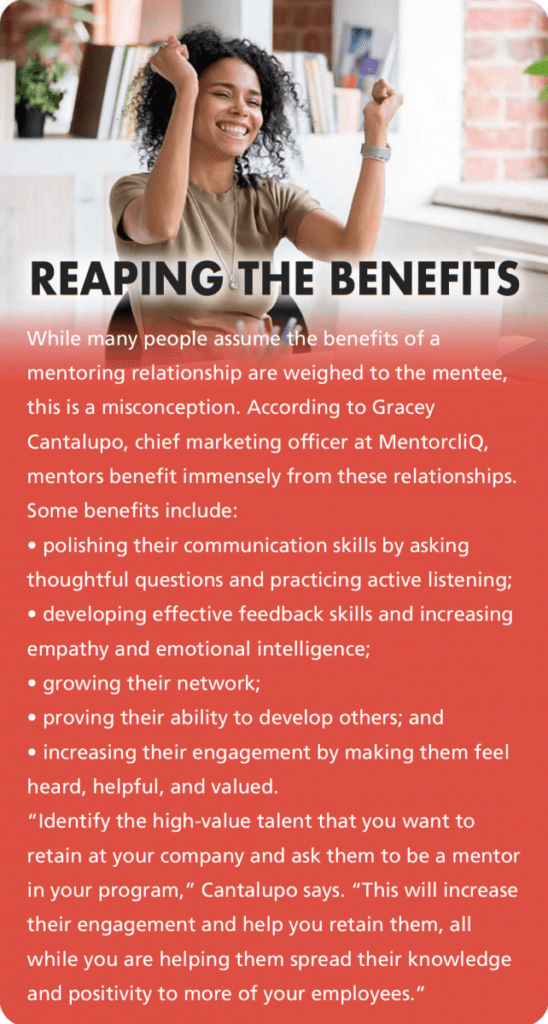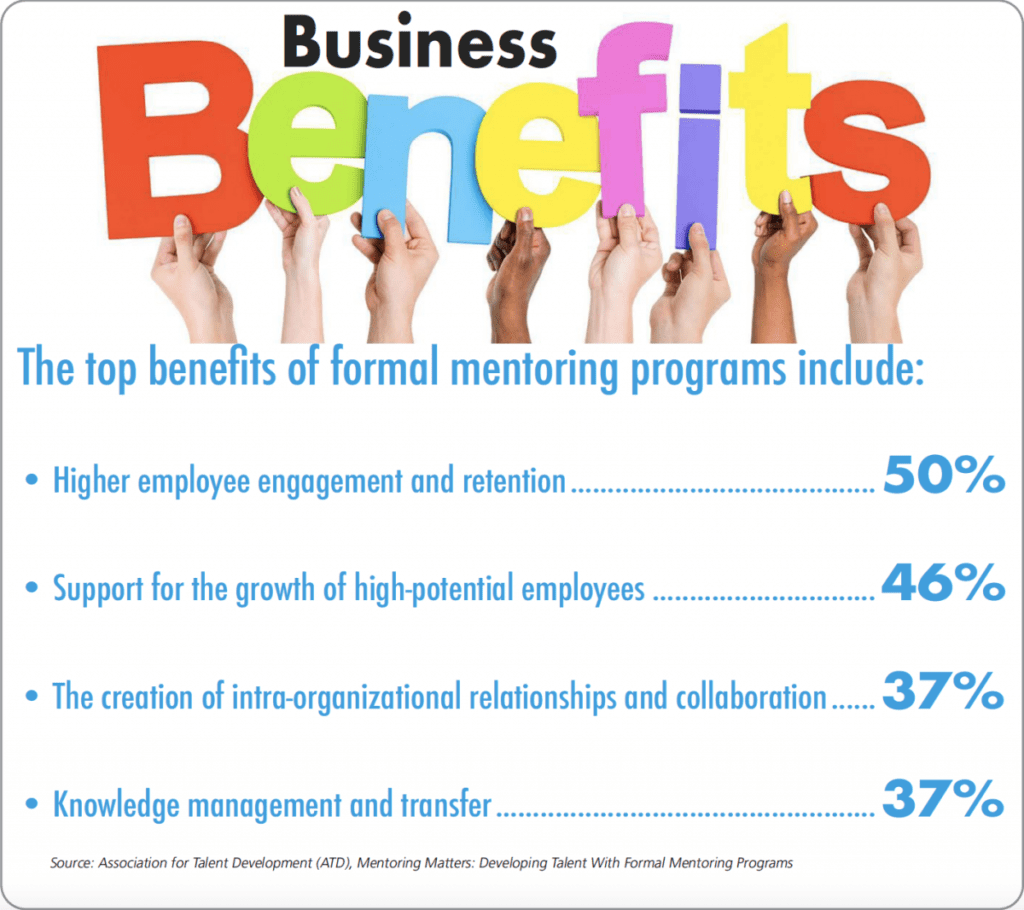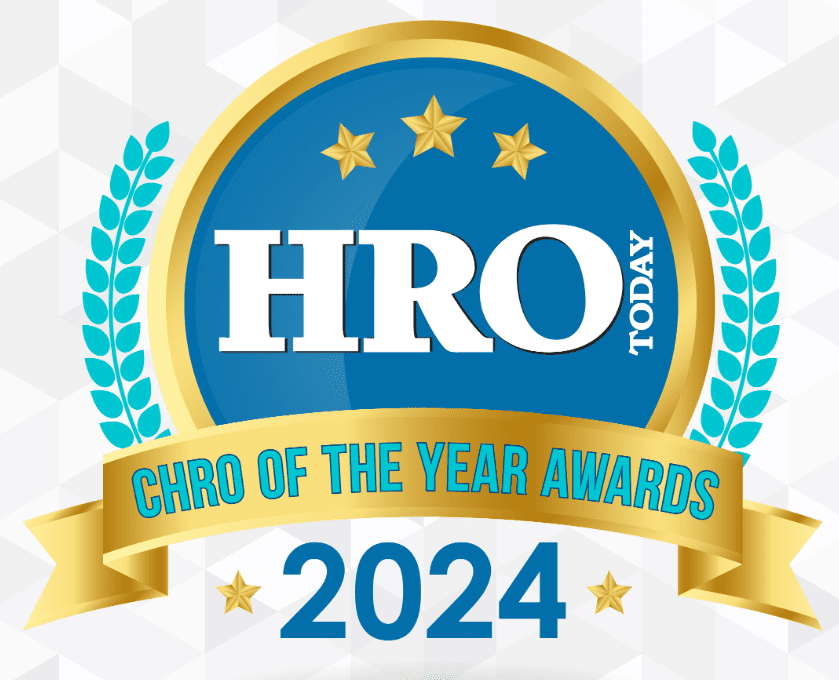Three organizations share their unique approaches to mentorship programs.
By Marta Chmielowicz
Mentorship has long been considered a powerful way to build trust and connection, expand knowledge, and enable high performing employees to reach their full potential. That is why it is a critical element of Digital Realty‘s leadership development strategy, particularly as the company transitions following an acquisition.
According to Kathy Smith, vice president and HR business partner, Digital Realty’s approach to mentorship has shown proven results, arming individuals with the critical skills they need to prepare for future leadership opportunities. In fact, one employee in the finance department with no prior leadership experience was able to expand his role and scope, taking on an interim international assignment before leading a team through an integration effort.
“By giving him an opportunity to learn from a leader who has a depth of experience and knowledge of leading complex projects and teams, it readied him to able to do something that we actually at the time had no visibility we were going to do -the integration of the company we purchased last year,” explains Smith. “The mentor program allowed us to identify that he had some critical skills that would be useful, and we just needed to give him some more tooling, guidance, and confidence to stretch into the new role that he’s in today.”
In addition to giving employees the skills and experience they need to succeed, mentorship programs deliver myriad benefits to mentors, mentees, and the organization as a whole, increasing the sense of connection, belonging, and engagement across teams. This is particularly critical in the post-pandemic workforce, where employees are likely to feel burned out, isolated, and disconnected from their peers.
“With more employees working remotely than ever before, mentorship is an important tool to navigate the nuances of the virtual workplace and to establish a human connection,” says Erin Lau, manager of HR services at Insperity. “Mentorship programs benefit businesses by fostering employee advancement, increasing engagement, and continuing professional development. Mentorship programs also bridge generational divides in the office, as mentors and mentees can help each other grasp a better understanding of any new workplace communications and processes.”
This translates to bottom-line business results. According to a study from the Association for Talent Development (ATD), Mentoring Matters: Developing Talent With Formal Mentoring Programs, the top benefits of formal mentoring programs include:
- higher employee engagement and retention (50%);
- support for the growth of high-potential employees (46%);
- the creation of intra-organizational relationships and collaboration (37%); and
- knowledge management and transfer (37%).
Here, three organizations -Digital Realty, ZebraTechnologies, and Schneider Electric -share their unique approaches to mentorship programs, with best practices HR leaders can bring home to their organizations.
Digital Realty
When Digital Realty acquired InterXion to expand its global data platform to serve EMEA, APAC, and the Americas, it needed a robust leadership development program to navigate the integration. According to Smith, mentorship offered a valuable opportunity to establish a strong leadership pipeline that could guide the newly expanded organization to success.
“Mentorship programs build an untapped talent base,” Smith explains. “By pairing strong leaders with individuals, you’re enabling people to be more engaged, more committed, and have more purpose within the organization, which creates a higher retention rate and a stronger workforce.”
Digital Realty’s mentorship program is tied directly to its business objectives. Every year, the company identifies top talent through a series of talent reviews and builds development plans around the individuals who are critical to succession planning efforts. A mentorship program spanning peer-to-peer, leader-to-peer, or external coaching opportunities is then designed to support those critical employees and fill any experience gaps.

To match mentees with the appropriate mentors, Digital Realty undergoes a collaborative and data-driven process. First, the HR team gathers information from a peer group of leaders who share the focus areas that they believe are critical to success in a leadership position. Then, HR does a “talent inventory” of the employees to understand their strengths, weaknesses, and any prior experiences that could align with the critical leadership characteristics identified by the leadership team. The following questions offer valuable insights.
- Has the individual led an integration effort?
- Have they worked in a global role?
- What initiatives have they led cross-functionally or within their business unit?
- What types of profit and loss responsibilities have they led?
“We look holistically at where the individual is in their current state,” says Smith. “It’s really important to have an inventory of each employee’s background and experiences. This leadership assessment gives us that granular insight into the employee. People come to work at Digital with great experiences, and if we don’t capture those, capitalize on them, and understand where the gaps are, we can’t really create a path forward.”
Within this process, the HR team also asks probing questions to understand the individual’s goals. For example, some mentees may be interested in growing in the role they have today, while others want to develop the skills needed for a future role. These goals are incorporated into the mentee’s development plan, and mentors are chosen whose skills and experience can support the development of those goals.
While experience is a critical factor in selecting a mentor, Smith says that HR leaders need to be sure that their mentors are “culture carriers” throughout the organization. To ensure true buy-in, employers should communicate the value of the mentoring relationship to both parties and offer facilitation guides and resources to enable thoughtful and engaging communication between mentor and mentee. For example, Digital Realty has developed a guide that includes preparation prompts for both mentors and mentees (see Figure 1), as well as a structured conversation guide for meetings and a resource list to find additional learning opportunities.
Zebra Technologies
Zebra Technologies takes a more hands-off approach to mentorship programs, embracing the philosophy that employees should own their own career journeys while receiving the managerial support they need to reach their goals. While the company does have a structured leadership training program that matches employees on the growth track with an executive-level leader, Jeff Schmitz, chief HR officer and chief marketing officer, says that more often than not, mentorships are self-initiated by employees -and that’s by design.
When employees express interest in a mentorship, their supervisor or direct manager works with them to evaluate what they are trying to gain from the relationship and help them find a match. Managers also regularly communicate the value of mentorship and career development, reminding employees of the resources available to them even when the burdens of the pandemic put career growth lower on employees’ priority list.
Oftentimes, mentees are encouraged to reach out directly to leaders who have the specific skills that they are hoping to learn. The company then offers a series of tools to ensure a positive relationship.
“We have in place a number of tool kits for both the mentor and the mentee,” Schmitz explains. “There’s guidance on the roles and responsibilities of those relationships, how to prepare for a meeting, conversation guides, and checklists. There are guides on mentoring plans, action plan templates, best practices and tips for mentors, and more. There’s a whole host of tools that are available to help both sides get the most out of the relationship.”

- How has the employee changed over the past three years? How would they like to evolve over the next three?
- What is one thing that differentiates them from anyone else?
- Ask them to describe their best day ever at work. What made it so great?
- What qualities and abilities do they admire in others?
- What parts of the business are they most excited about?
From there, the mentor and mentee can set and agree on expectations for the relationship, including preferred methods of communication; frequency, length, and format of meetings; individual preferences for giving and receiving feedback; and shared goals. Schmitz recommends that leaders use the “SMART” goals framework to guide this process, creating goals that are specific, measurable, attainable, relevant, and time bound. From there, they can create action plans that are evaluated at each subsequent meeting.
However, Schmitz emphasizes that while mentoring relationships may begin with a clear structure in place, they are ever-changing. “Hopefully, you’re building relationships that are ongoing. Maybe they become less formal over time, but the purpose of mentorship is to build a relationship so it’s not a mentor call anymore -it’s just a conversation,” he says.
According to Zebra’s mentoring guide, there are many different ways leaders can show up for their mentees, including in roles such as:
- advisor, who acts as a sounding board and facilitator;
- developer, who helps identify career opportunities and gives structure and direction;
- leader, who models the company’s core values through actions and coaching;
- affirmer, who offers support, empathy and understanding; and
- sponsor, who advocates for the mentee.
As the relationship develops and becomes less formal, the roles that mentors play in the lives of their mentees will shift and evolve, often becoming more reciprocal.
According to Schmitz, this shift is particularly valuable for leaders interested in learning about employees’ experience of diversity and inclusion in the organization.
“The idea of mentorship isn’t a one-way interaction,” he says. “As we focus on DEI, reverse mentoring is part of this as well. We ask the executives to meet with people who aren’t like them -different generations, genders, backgrounds, ethnicities. They should use it as an opportunity to learn how employees are experiencing the company or life in general, and make sure they’re learning from it too.”
For example, Schmitz is engaged in a mentoring relationship with an LGBTQ+ identifying employee. While the focus of their conversations is certainly the employee’s career advancements, he says that he views the relationship as a valuable chance to glean deeper insight into how she experiences Zebra and how the company can create a more inclusive environment for people like her.
“If you can build the trust in the relationship and get to that level of discussion, it’s really valuable to the mentor,” he explains. “And for my mentee, she sees that I’m listening and I’m in a position to influence the culture of the company more than others, so I think that’s really powerful. I think she feels more connected to the company. She knows the efforts we’re making to create a more diverse and inclusive culture, and she knows I’m learning from her.”
Schneider Electric
Mentoring is also a significant part of the talent management strategy at Schneider Electric, offering opportunities for exposure to knowledge, greater awareness of available career paths, and employee connection with business partners outside of their day-to-day teams.
Mai Lan Nguyen, HR senior vice president of North America, says that the company encourages three forms of mentorship:
- organic mentoring relationships;
- mentoring through an artificial intelligence (AI)-powered “Open Talent Market” (OTM) platform and through the talent review process; and
- a structured group mentoring program.
The digital OTM is a disruptive technology that offers employees a view into all available opportunities that align with their skillsets, creating a one-stop-shop for career development. Employees upload their profile to the OTM (or connect it to their LinkedIn), identify specific areas where they want to learn and build their skills within the company, and receive AI-suggested development opportunities based on their skills, competencies, and future goals, including:
- full-time roles;
- part-time projects;
- mentoring opportunities; and
- suggested courses found in the learning management system.
“Mentors can volunteer on the platform as well, identifying the skills and experience that they can offer to share with others,” explains Nguyen. “This puts the employees in the driver’s seat to develop their mentoring skills and find a role model that they can learn from.”
On top of being user-friendly and intuitive, the OTM creates a network of expertise throughout the organization that has many benefits for both employees and the organization. Employees can easily acquire a portfolio of experiences and skills, while leaders can find talent faster to build diverse teams. Greater transparency around available roles and projects also drives engagement and reduces attrition and turnover in the workforce.
In the group mentoring sessions, leaders volunteer to work with a group of three to four employees over a five-month period, offering advice on how to navigate the business world and grow their careers.
“In the design of the group mentoring program, we established a roster of topics for our participants to cover during each meeting that we felt would engage them and help them gain the most benefit from their sessions,” says Nguyen. “From the participants’ perspective, their level of engagement is tied directly to the value they see in the program. If they are gaining value, they will be more apt to engage further and maintain that open dialogue, even on beneficial topics outside of the program.”
However, Nguyen emphasizes that the most successful mentor-mentee relationships are the organic ones that grow without formal structure. When employees are comfortable confiding in their mentor, discussions thrive -even in times of crisis.
Strategies for Success
What are some best practices HR leaders can implement to ensure a positive mentorship experience for both mentors and mentees?
1. Communicate the value. “In today’s environment, we have seen employees challenged by additional responsibilities when working remotely, whether that be a child schooling from home or other family members needing their attention,” says Nguyen. It’s important to reinforce the value of the mentoring program with the participants -especially in the early stages -to ensure that they recognize it as a priority and are able to make the time to actively participate.”
Gracey Cantalupo, chief marketing officer at MentorcliQ, suggests that HR leaders communicate that mentoring is an essential part of the employee’s role -not an additional responsibility to pile on their plate. This can avoid the burnout that many of today’s employees are experiencing in the remote workplace, driving greater engagement and productivity in the program.
2. Embrace genuine connection. Today’s employees spend much of their time on Zoom, Microsoft Teams, and other collaboration platforms, resulting in meeting fatigue that can impact mentorship participation.
According to Insperity’s Lau, some organizations are responding by encouraging mentors to offer support and coaching around work-life balance. Today’s mentors are more transparent about their own workforce challenges and the solutions that worked for them, and are more likely to encourage employees to take time to disconnect or make use of their paid vacation.
This vulnerability can go a long way to building trust and authentic connection between mentors and mentees. “Transparency creates a safe space for mentees to share their own challenges,” says Lau. “Informal meetings are better suited for building a personal connection; mentors should try scheduling light and fun video calls such as virtual coffee breaks or happy hours. However, during any mentee interaction in the remote world, it is important to determine if the mentee is overwhelmed by workplace pressures and to always practice compassion while advising. Most of all, mentors should focus on what is most important -the relationship.”

According to Cantalupo, the first step to creating such an authentic relationship is making a good match. She recommends that companies leverage technology-enabled “Bring Your Own Purpose” programs where connection is the main goal. In these programs, participants who enroll are asked to share their interests, such as development goals or hobbies like writing, cycling, or baking. Then, the algorithm matches participants with leaders who share similarities in their interests and personality.
“This helps employees connect with each other on a personal level which humanizes their colleagues and creates deeper connections, increasing engagement, workplace happiness, and ultimately employee retention,” she explains.
3. Keep it simple. While technology can greatly enable the facilitation of mentorship relationships, adopting easy-to-use platforms is critical -particularly for programs that include 50 or more participants. “You want your technology to be simple and not overcomplicate things. If you make too many steps or too many tech hurdles, this gets in the way of mentoring relationships,” says Cantalupo.
Adopting a program that integrates with internal collaboration tools is one way that organizations can streamline the mentoring process. This way, employees can book meetings, chat, or video call with their mentor directly through a mobile-accessible platform.
Cantalupo says that having a solid technology platform can also help HR leaders measure the effectiveness of their mentorship programs, revealing key metrics like:
- hours spent mentoring;
- goal progress and completion; and
- mentor/mentee satisfaction.
These can be evaluated alongside program-level metrics like retention and promotion rates to understand the ROI of mentorship.
4. Remain flexible. Mentorship is a journey, and successful programs need to remain agile and flexible to adapt to the changing needs of the workforce.
“Mentorship can’t be rigid -it has to grow and evolve over time,” says Smith. “We’re on that journey right now -we’re already working on the next iteration of our program. You should always continuously think about how to pivot and make it better for the employees, not for the company.”
For example, while Digital Realty has a robust mentoring program in place, it plans to expand its efforts into a formalized program leveraging a tool, MentorcliQ, that can facilitate mentorships more holistically throughout all levels of the organization.















